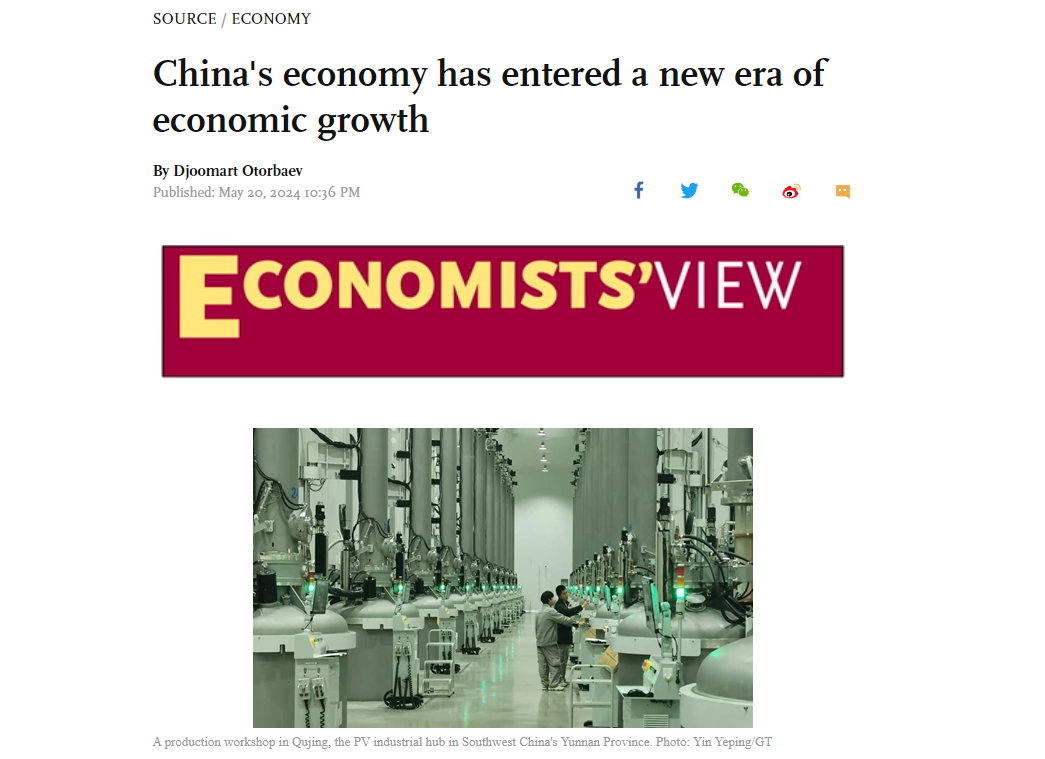LATEST INSIGHTS
Your Present Location: LATEST INSIGHTSDjoomart Otorbaev: China's economy has entered a new era of economic growth
Source: GT Published: 2024-05-20

Implementing new investment principles, particularly in advanced technology and clean energy manufacturing, has heralded a transformative era for China's economy. This shift has led to stable and sustainable growth and holds promising prospects for the future.
At home and abroad, numerous analysts have long predicted a slowdown in China's economy, attributing this to a fundamental overhaul of its economy. A transition period was expected from the model of predominant real estate to high-technology industries and clean energy investment.
However, despite the forecast challenges, the Chinese economy as a whole has shown remarkable resilience, thanks primarily to the accelerated growth of the high-tech and clean energy industries.
As anticipated, the real estate sector and foreign investment have experienced a decline. In the first quarter of this year, compared to last year, investment in the real estate sector has fallen by 9.5 percent, aligning with earlier predictions, according to a report from Reuters.
The declining condition of the real estate market has a major adverse effect on overall consumer spending, given that an exceptional 70 percent of Chinese households have their wealth invested in real estate.
What was a complete surprise was that the overall economy started the year unexpectedly positive. In the first quarter, the GDP increased by 5.3 percent compared to the previous year, fueled by the high-tech and clean energy industries, which experienced faster growth. Industrial production grew by 6.1 percent. The high-tech manufacturing sector registered a growth of 7.5 percent, accelerating by 2.6 percentage points from the fourth quarter of 2023. Investment in high-tech industries has experienced robust growth, increasing by 11.4 percent from the previous year.
Notably, the production of 3D printing equipment, electric vehicle charging stations, and electronic components has grown significantly by about 40 percent year-over-year. China's manufacturing industry successfully navigates the global economic landscape by focusing on three emerging high-tech sectors: electric vehicles (EVs), solar panels, and batteries. According to Chinese customs data, only exports of these three positions increased 30 percent last year to $147 billion.
China's impressive economic growth over the past few decades is primarily attributed to its massive investments, especially in some priority areas. According to the World Bank, the average investment is 25 percent of the global GDP. In developing countries with high levels of investment, this figure can reach up to 30 to 34 percent. However, China's investment rate has remained above 40 percent for over 20 years. Approximately two-thirds of China's total investment has been made in real estate and infrastructure.
A few years back, the Chinese government introduced a series of policies, including 'three red lines' for real estate companies in 2021, to control speculation in the housing market sector.
This policy was later extended to provincial and local governments, which invested significant sums in construction and infrastructure. The strategic decisions made several years ago to shift major investments from the real estate sector to manufacturing advanced clean energy equipment are now delivering excellent results.
In a swift move, the country's financial system shifted its focus. Within a short time, it was able to switch enormous resources toward financing high-tech industries, redirecting funds away from the real estate sector. The latest official data indicates that the shift has already occurred. Pan Gongsheng, the governor of the People's Bank of China, stated in January that the growth rates of green, short-term technology loans, and long-term manufacturing loans significantly outpace overall lending growth in 2023. In the meantime, the demand for loans in the real estate sector and local government financing has sharply decreased.
The Chinese government is continuing to pursue accelerated reforms through proactive measures, including reducing interest rates for high-tech manufacturing. This is also why the expectations of market participants show positive dynamics. China's manufacturing purchasing managers' index (PMI) rose in March for the first time in six months, and the Caixin/S&P manufacturing PMI also hit its highest level in over a year.
According to the World Bank, Chinese factories currently contribute around 28 percent of the country's GDP, which is higher than the global average of 16 percent. China's share in global manufacturing is impressive 31 percent. Therefore, the country's remarkable success in rapidly transforming its enormous manufacturing potential and shifting toward high-tech products is awe-inspiring.
Historically, China has been known for manufacturing and exporting low-cost electronics and engineering products. However, the country is becoming increasingly competitive and dominant in several advanced technologies, such as EVs, solar panels, wind turbines and battery materials. China has rapidly caught up with or surpassed leading countries in various fields, including computer chip production, artificial intelligence, autonomous vehicles, nuclear fusion, quantum computing, hydrogen production, spacecraft, and biomanufacturing. All of this provides the world with reasons to be optimistic about the country's future development.
The author is the former prime minister of Kyrgyzstan, a distinguished professor of the Belt and Road School of Beijing Normal University, a member of Nizami Ganjavi International Centre, and the author of the book 'Central Asia's Economic Rebirth in the Shadow of the New Great Game.' bizopinion@globaltimes.com.cn























































































 京公网安备 11010802037854号
京公网安备 11010802037854号





